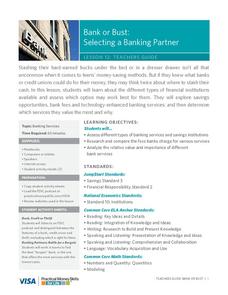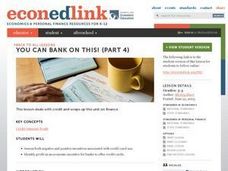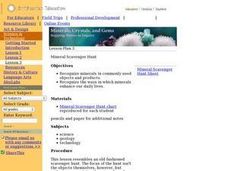Curated OER
Lesson 1: Bacteria on the Run
Students discuss bacteria. In this bacteria lesson, students see how bacteria in foods can cause illness and how to keep yourself safe. This lesson contains five activities and pre and post tests.
Curated OER
What's Cooking? It Starts with a Plan and a List
Students create a meal plan for their family. In this adult health science instructional activity, students discuss the benefits of using a shopping list. They explain how these methods can help them save time and make healthy meals.
Curated OER
Just Lookin' For a Home
What is a boll weevil? Your class can find out that and more by following the activities included here. Pupils read an article, sing a boll weevil song, add to the song with their own original lyrics, illustrate the song, study the...
Curated OER
Fresh Greens In The Home
Young scholars engage in the study of nutritional food choices that include fresh greens. They investigate the benefits of using simple planting techniques. The lesson also includes recipes for students to try out the habit of eating...
Curated OER
History Close to Home: Creating Your Own Special Museum
Students create their own museum exhibit. In this museum creation lesson plan, students research their local history so they can decide on a theme for their exhibit and what objects they will use in order to design a museum exhibit. A...
Council for Economic Education
Banks and Credit Unions (Part 1)
Imagine you have money you want to save ... where do you put it? Pupils investigate the similarities and differences of banks and credit unions as they determine where exactly to place their hard-earned money. Through a WebQuest, they...
Visa
Bank or Bust: Selecting a Banking Partner
Why shouldn't we just save all our money in our mattress? Couldn't our money disappear? Pupils discover the benefits of utilizing banks and credit unions for saving money, as well as how to evaluate different types of institutions by...
Curated OER
Lesson 1: The Image of Maine in Sinclair Lewis' Babbitt
Pupils study excerpts from Sinclair Lewis, "Babbitt" for its accuracy and socio-economic point of view. They rewrite a portion of "Babbit" using the point of view of a Maine guide.
Curated OER
Made in the USA
Students map products made in the United States. They discuss regional interdependence and identify goods the U.S. produces and trades. They describe how economic links make Americans more alike, and locate major manufacturing centers in...
Curated OER
Map It!
Fourth graders collect and explore different maps and their uses before using the program Pixie to create maps of geographic features, political features, and economic information for the state in which they live.
National First Ladies' Library
Secretary of Commerce
Middle schoolers gain understanding of economic history of United States in twentieth century by examining role of Department of Commerce. Student groups each analyze one quarter of twentieth century by researching role of Department of...
Curated OER
WWI and Twenties & Thirties
Young scholars study economics and timelines of events to understand changes in America. In this Twenties and Thirties instructional activity, students navigate Internet sites to research famous reformers. Young scholars recognize the...
Curated OER
An Introduction to the Federal Reserve
Students examine the Federal Reserve System. In this secondary economics lesson, students view a DVD titled In Plain English: Making Sense of the Federal Reserve. Students take notes and work in groups to review the information. ...
Curated OER
Once Upon A Time...
Students discuss elements of fairy tales, examine selected piece of Robert Harris' art, and compose fairy tales based on what they see and imagine. Students then view homes in Harris' artwork collection, create home in which they would...
Curated OER
Bring No Poor Articles with You
Students compare their travel needs to homesteaders from the late 1800's in this multi-lesson unit. Students analyze a historic document, explain modes of transportation of the homesteaders, and articulate the personal and economic...
Curated OER
Can We Be Both Conservationists and Consumers?
High schoolers explore their role as consumers and conservationists and what roles they play in today's economic climate. They explore resource allocation issues. Students analyze data and draw comparisons between historical and...
Curated OER
Fair Housing Lesson 4: Constitutional Hearing
Students investigate fair housing issues in the United States. In this government lesson, students watch "No Place Like Home," and then prepare to participate in a classroom simulation that requires them to act as state legislators and...
Council for Economic Education
You Can BANK on This! (Part 4)
Students assess both negative and positive incentives associated with credit card use. They identify profit as an economic incentive for banks to offer credit cards.
Curated OER
Immigration: A History
Studnets trace how immigration patterns have changed in America's history. They analyze the relationship between economic growth and immigration.
Curated OER
A Day in the Life
Students inquire about the politics and culture of Ancient Rome. In this Ancient Rome project/unit, students research life during ancient Roman times and create a newspaper with articles on politics, sports, culture, and economics.
Curated OER
The Federal Reserve
Students explore the role of government in the economy market. In this economics lesson, students analyze the decision making and how it takes into consideration additional cost, benefits and public awareness of what they are trying to...
Curated OER
Deerfield Visit: Reading a House/Place (Ebenezer Hinsdale Williams House)
Eleventh graders study the relationship between economic level and material culture: markers of gentility (architecture, material goods) as demonstrated by a single structure.
Curated OER
Mineral Scavenger Hunt
Students complete a scavenger hunt worksheet as they find examples in their classroom, at home, etc., of minerals. Excellent worksheet!
Curated OER
Create a Classroom Exhibit: Rocks and Minerals
Students bring in rocks and minerals from home. They observe them and describe them carefully, completing a worksheet. Finally, a classroom exhibit is created.
Other popular searches
- Home Economics Curriculum
- Home Economics Lesson Plans
- Technology in Home Economics
- Home Economics Lessonplans
- Home Economics Special Needs
- Home Economics Videos
- Home Economics Child Care
- Home Economics Education
- Asia Home Economics
- Home Economics Civil Rights
- Vocational Home Economics
- What Is Home Economics

























